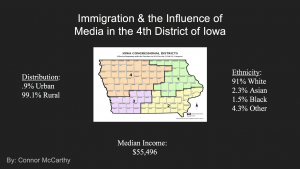
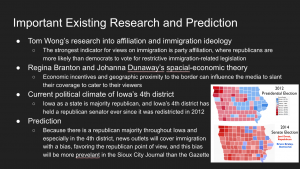
News outlets provide the public with up to date and reliable information regarding current events in America as well as internationally. However, although news organizations are encouraged to convey information as matter-of-fact, the inherent structure of such institutions provide clear motives to produce biased stories. When considering the media in the republican state of Iowa, it is imperative that we put their reportings into context as opposed to reviewing their stories independent from existing conditions. More specifically, when analyzing the media through the lense of immigration, extant literature shows there is a tendency to exaggerate the stories in order to attain readers. As many news outlets are privately held entities, just like companies in other industries, there is a fundamental impulse to maximize profit. In Regina Branton and Johanna Dunaway’s spacial-economic understanding of media slanting, they contend that news organizations release their stories in order to attain viewership and thus “news is produced in the manner that is most pleasing to audiences” (Branton, 259). In which direction this slant leans is dependent on one’s spatial proximity to the border. However, when discussing the state of reporting in Iowa, although relatively far from our southern neighbor Mexico, I would predict their stories would cater to their republican citizens. Echoed through extant research is the understanding that party affiliation has the strongest effect on immigrant ideology. Thus, grounded in the belief that “Republican legislators are significantly more likely than Democratic legislators are to vote for restrictive immigration-related legislation,” states with republicans majorities would likely experience rhetoric with right-winged sentiment (Wong, 16). The fourth district of Iowa, which has encountered multiple redistrictings over the years, has elected a republican representative since its inception dating back to 2012. Furthermore, Steve King has served as the incumbent during this time and has adopted far-right policies and beliefs during his tenure. An avid supporter of Trump’s declaration for a wall, King was even removed from the federal Judiciary and Agricultural committees following his white supremist remarks. Having mobilized such a support base for nearly twenty years, and boasting the largest margin of victory of any district in the last election, King’s followers clearly back a similar republican viewpoint (Ballotpedia). Although the 2nd district elected a democratic congressman, by a slim margin no less, the 1st and 3rd districts have republican representatives as well. In analyzing news articles from the the Gazette and and The Sioux City Journal (SCJ) I hypothesize that the republican majority across the state will result in a distortion of the media as it relates to immigration slanted in the republicans favor. Furthermore, there may be a more extreme bias throughout the Sioux City Journal pieces than the Gazette articles.
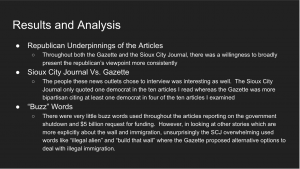
To better understand this relationship between partisanship and media coverage, I will analyze the Gazette and the Sioux City Journal. I chose these two newspapers to gauge the temperament of the Iowa population pertaining to the government shutdown and the debate between Trump and congress about funding for the border wall. Across multiple websites the Gazette is cited as the most popular news outlet for Iowans to access stories statewide. However, this material may not be representative of the feelings towards this issue specific to King’s district. Thus, I will also analyze stories released by the Sioux City Journal which produces the most read reports from the local area around Sioux City, within King’s district lines. Although cities tend to lean more democratic in nature, the SCJ should still give us insight into the 4th districts opinion on these matters. During this study I will simply examine the top ten articles which I find while googling about the government shutdown for each respective outlet. While evaluating these two organizations, I set up some variables in order to quantify partisanship to some extent so I could more effectively compare the two as well as construe some larger meaning. These variables include the frequency of buzzwords use to invoke a sense of fear or anxiety, the party affiliation of each respective reporter as well as those who are interviewed in each piece in addition to a qualitative account of the material at large. Utilizing these metrics, I will test the hypothesis that the party affiliation of readers influences the media to publish slanted stories.
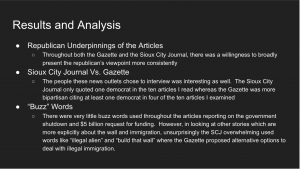
While reviewing the articles released around the time of the the government shutdown, though both sides of the argument were acknowledged, there is a hint of republican preference among the stories. Throughout all of the articles, both the Gazette and Sioux City Journal, journalists commonly detail the limitations this shutdown has imposed, citing the number of workers out of a job as well as listing the government agencies that are low on funding. However, especially in the SCJ, reporters shape the issue as a common inefficiency of the government as opposed to being caused by an impractical stubbornness on behalf of the president. This news organization also shows a tendency to belittle this issue. For example, while outlining the number of workers out of a job, Erin Murphy of the SJC reported that “Iowa’s leaders insist state programs are not in immediate danger” (Murphy). Republican senate majority Leader Jack Whitver explained how they will continue to monitor the status of the federal government and the related issues “but [that] none of those [issues] has arisen to the point where there’s any action ready to be taken” (Murphy). What is also interesting is the number of republicans and democrats who were represented in these news articles. For the SCJ, of the ten articles I examined, all but one exclusively interviewed republicans. In the one article they mentioned a democrat, it was in reference to Nancy Pelosi’s accusation that Trump is using the aura of the wall funding to divert attention from the Mueller investigation. However for every disparaging remark about Trump, there was plenty of counter-arguments supporting Trump’s request for $5 billion dollars of funding and dismissing the imminent danger that the longest government shutdown in history has presented. In another article, the Republican senator Lindsey Graham’s tweet was quoted saying “Mr. President, declare a national emergency NOW. Build a wall NOW” (Lemire et al.). The support for Trump’s eagerness to defend the border was also supported by White House senior adviser Stephen Miller in a SCJ story when he said, “we’re going to do whatever is necessary to build the border wall to stop this ongoing crisis of illegal immigration” (Hayworth). The Gazette, while also pushing this republican narrative, did display a willingness to promote the democratic side of the story as well. Throughout their interpretations of the situation in the White House, they frequently displayed the disagreement between Trump and congress as a ‘national crisis’ and something that needs to be figured out as soon as possible. In Nicholas Johnson’s article, he critiqued the Trump administration’s push for a large wall on the border and believed that they should focus on the cause of the problem as opposed to simply building a wall. In Mehaffey’s work, she quoted Ken Runde, the U.S. Marshal for the Northern District of Iowa as complaining how “it’s unfair to the employees who have to work without pay,” shedding light to the real life financial struggles these federal workers were experiencing (Mehaffey). The link between the politics of immigration and the struggle this shutdown posed to government agencies who struggled to serve people in need was made more clearly in the Gazette’s articles.
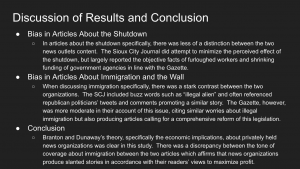
While reviewing the articles released around the time of the the government shutdown, though both sides of the argument were acknowledged, there is a hint of republican preference among the stories. Throughout all of the articles, both the Gazette and Sioux City Journal, journalists commonly detail the limitations this shutdown has imposed, citing the number of workers out of a job as well as listing the government agencies that are low on funding. However, especially in the SCJ, reporters shape the issue as a common inefficiency of the government as opposed to being caused by an impractical stubbornness on behalf of the president. This news organization also shows a tendency to belittle this issue. For example, while outlining the number of workers out of a job, Erin Murphy of the SJC reported that “Iowa’s leaders insist state programs are not in immediate danger” (Murphy). Republican senate majority Leader Jack Whitver explained how they will continue to monitor the status of the federal government and the related issues “but [that] none of those [issues] has arisen to the point where there’s any action ready to be taken” (Murphy). What is also interesting is the number of republicans and democrats who were represented in these news articles. For the SCJ, of the ten articles I examined, all but one exclusively interviewed republicans. In the one article they mentioned a democrat, it was in reference to Nancy Pelosi’s accusation that Trump is using the aura of the wall funding to divert attention from the Mueller investigation. However for every disparaging remark about Trump, there was plenty of counter-arguments supporting Trump’s request for $5 billion dollars of funding and dismissing the imminent danger that the longest government shutdown in history has presented. In another article, the Republican senator Lindsey Graham’s tweet was quoted saying “Mr. President, declare a national emergency NOW. Build a wall NOW” (Lemire et al.). The support for Trump’s eagerness to defend the border was also supported by White House senior adviser Stephen Miller in a SCJ story when he said, “we’re going to do whatever is necessary to build the border wall to stop this ongoing crisis of illegal immigration” (Hayworth). The Gazette, while also pushing this republican narrative, did display a willingness to promote the democratic side of the story as well. Throughout their interpretations of the situation in the White House, they frequently displayed the disagreement between Trump and congress as a ‘national crisis’ and something that needs to be figured out as soon as possible. In Nicholas Johnson’s article, he critiqued the Trump administration’s push for a large wall on the border and believed that they should focus on the cause of the problem as opposed to simply building a wall. In Mehaffey’s work, she quoted Ken Runde, the U.S. Marshal for the Northern District of Iowa as complaining how “it’s unfair to the employees who have to work without pay,” shedding light to the real life financial struggles these federal workers were experiencing (Mehaffey). The link between the politics of immigration and the struggle this shutdown posed to government agencies who struggled to serve people in need was made more clearly in the Gazette’s articles.









